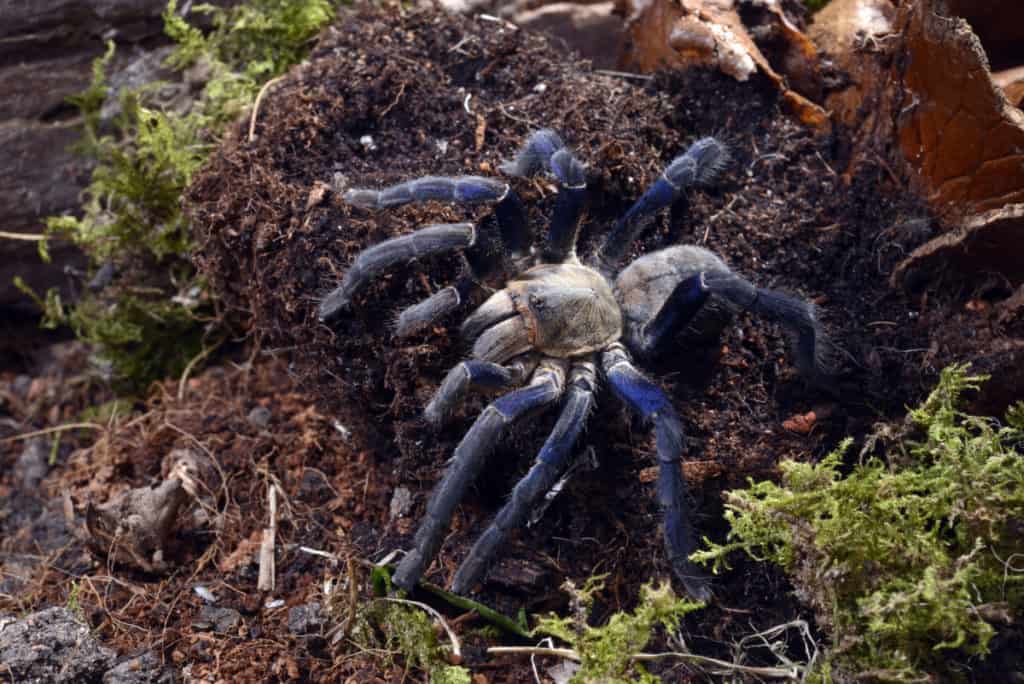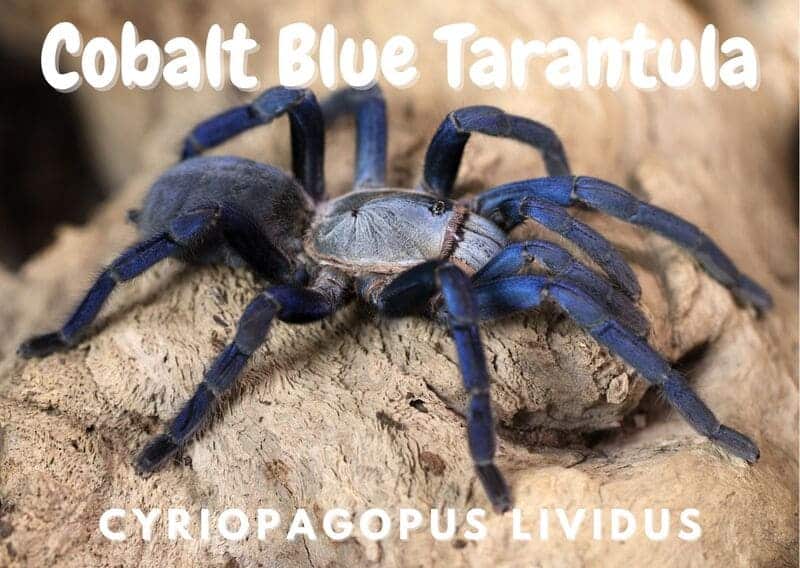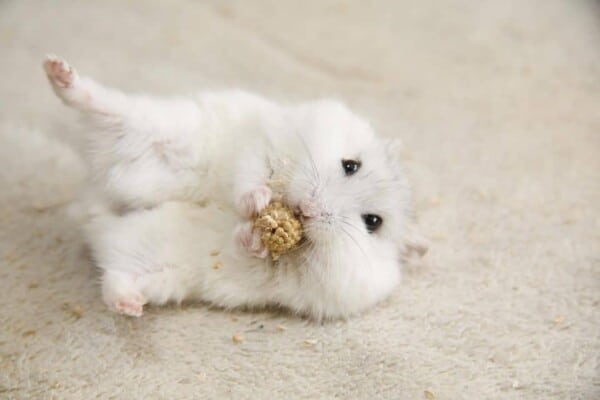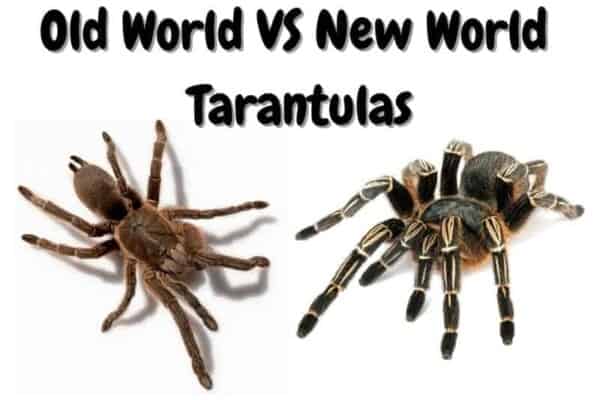The cobalt blue tarantula is a stunning color spider that is native to the Thailand region. It needs special requirements that allow it to survive in a tropical rainforest climate.
They are recommended for advanced owners who like the thrilling beauty and their aggressive nature. If you have some years of experience with burrowing spiders, the cobalt blue might just be for you.
Cobalt Blue Tarantula Overview
| Scientific Name | Cyriopagopadus Lividus (formerly Haplopelma lividum) |
| Dwelling | Terrestrial |
| Size | 6 to 9 inches |
| Lifespan | 5-6 years (male) / 15-18 years (female) |
| Food | Cockroaches, crickets, beetles, mealworms, moths, small pinky mice |
| Difficulty | Advanced |
Cyriopagopus lividus- Recently reclassified in 1996 by the same expert, it was formerly identified as Haplopelma lividum by Andrew Smith (1990). This new species’ name is hotly debated by online experts to no avail.
Characteristics of the Cobalt Blue Tarantula
The unmistakable cobalt blue legs and iridescent greenish-blue cephalothorax give this species its true name. It is sometimes dusted with yellowish fuzz-like hair that covers much of the carapace and abdomen. Subtle differences can include black upper legs, and a bright yellow band that circles the outer carapace.

Some can even have white ornamental carapace markings and a radiant white decorative stripe on the abdomen. Legs can also feature white splashes on the joints followed by yellow highlights.
Other variations can include beige and tan colors on the cephalothorax and abdomen. Some will also have a faint dark stripe down the middle of their abdomen. Just under their fangs, their mouthparts are a bright red color. Spiderlings are light blue.
Size
Adults will measure 13-14cm in length (5-6 inches) but can grow to 9 inches in length in the wild. The body length is 2.0 – 3.3 inches (5.3 – 8.5cm) for females, and all males are half this size.
Little spiderlings will be 1cm, but grow and molt quickly reaching 1 inch in the first year alone. Males can mature in the first year, so they are extremely fast-growing.
Temperament
These are very feisty spiders and will have a defensive personality. They are considered to be very sensitive and skittish and will immediately strike a threatening pose when approached.
Cobalt Blue tarantulas are experts at escape, so an enclosure must be professional and foolproof. They have no urticating hairs so there is very little warning they will give before an attack.
This video from Exotics Lair is a perfect illustration. See how her bad temper makes the rehousing process difficult.
Lifespan
The females are known to live up to 30 years in the wild. Many private keepers report they live as long as 20 years. Males don’t last as long in retrospect since their lifespan will be around 5-8 years.
Difficulty of Care
This species is absolutely an advanced spider. Due to their temperament, they do not make a good pets for beginners or intermediate enthusiasts. They can suddenly bolt out of an enclosure and escape just for being spooked. Just touching or bothering them seems to make them more nervous. They will bite or threaten to bite when approached.
Housing the Cobalt Blue Tarantula
This sized spider needs a 5-10 gallon tank enclosure that has a very secure top lid. Side-opening access doors should be escape-proof as well. It should be glass for long-term housing and better viewing conditions. Plastic can scratch too easily over time and will become cloudy.
If you are an advanced keeper the choice of tank is at your discretion. With this species being as defensive and prone to escape, the tank choice is more maximum security lock-down scenario kind.
Cleaning
You will need to clean this spider terrarium once a month since it likes to burrow. This means the substrate will be more at risk of bacteria from the humidity.
Besides cleaning up the left-over insect bolus, any left-over insects will also try to find a hiding spot. They must be removed since they might carry parasites or mites. This species is also a heavy webber so cleaning out excess webbing will be part of that job too.
Accessories
If you like to decorate your habitat, there is no end to the extras you can put inside. Half-shell coconuts or ceramic hides are nice. You can add real or plastic plants, bark pieces, or even a decorative back wall that is jungle-themed. This species is not a climber but it might like obstacles it can web over.
Humidity
This sub-tropical cobalt blue spider needs between 72-82% humidity at all times. It lives in the jungle rainforests of Thailand where the weather is balmy and wet. To get the humidity to continually radiate in the enclosure, add a heating pad (outside) just under the tank. It should be temperature adjustable. You need to spray the tank daily with water to keep the humidity high enough.
Temperature
Your spider will also like the temperature nice and warm at 80-90F all year long. The heating pad will give the needed heat that should stay in the tank. The lid should have venting to allow some air to get in, but not much to lose the heat. Another reason why this spider is hard to take care of is the heat and humidity this spider needs to thrive.
Lighting
This is one addition that you can skip altogether. It lives in dense rainforest conditions where direct sunlight is minimal. You don’t need a lamp unless you use a dimmable LED light that can give just enough to see the spider. It avoids light and is usually inside their burrow. They only come out to drink water and hunt for food.
Substrate
Because of the high moisture level in this enclosure, your substrate must be 100% sterile before it goes into the tank. Bacteria that live in topsoil, moss, and anything organic you put into the tank need to be baked in the oven at 150F for 1 hour. After that, it will be considered sterile enough for your spider. Mix 25% topsoil with 25% vermiculite and add 25% peat moss with another 25% coconut fiber.
After it is baked it needs to be filtered or bottled drinking water to give it packing power. If you can form the mixture into a ball, it’s ready to use. It should have a clay-like consistency. Put this into the tank, it needs to be 4-6 inches thick. These spiders will make tunnel burrows and like a substrate that holds its shape.
Feeding your Cobalt Blue Tarantula
They dine on cockroaches, crickets, worms, beetles, flying insects and moths, and even small pinky mice. They are predators and will hunt them with aggression. But if they do not eat any offerings, remove them from the habitat. Crickets and grasshoppers are known to attack spiders, so these insects are more stress-related than anything.
How often do they need food?
Adults are hungry eaters and can consume up to 5 crickets per week. They might like a single Dubai cockroach instead. What they don’t eat, you need to remove from their tank immediately.
Before molting they will stop eating to shrink inside their exoskeleton. Don’t feed them until a minimum of 6-8 weeks after they molt. Spiderlings eat more often – twice a week for the first year. Give them small-head crickets, wax worms, and insects that are the size of their cephalothorax.
Drink
They do like to drink water so use any small shallow cap 2 inches in diameter. It should be fresh water daily and be placed in the tank at the same level as the substrate. Despite the high humidity, they need water to not become dehydrated.
Handling the Cobalt Blue Tarantula
This spider is aggressive, despite the online websites that say they are otherwise. They spook very easily and are known to bite if given any reason. Their bite is painful too, though the venom is not lethal.
Bite symptoms can resemble influenza fevers and wasp-like stinging pain. Anyone who is the least bit allergic to bee stings should beware. Handling is not advised at all. A bite should also be treated with proper medical attention since bacterial infections can become fatal too.
Common health problems of the Cobalt Blue Tarantula
This species is not one for health issues aside from that, their habitat needs to be hot and humid. The problem that you need to look for is bacteria and parasites living in such a rich moisture substrate. These can plague the Cobalt blue tarantula and lead to certain death.
Mites are very problematic as well since they can swarm the spiders’ mouthparts and kill them that way. Empty insect bolus is prone to rotting so these must be removed to keep bacteria from spreading elsewhere in the tank.
Breeding the Cobalt Blue Tarantula
After three years, spiders will finally reach their reproduction age. They will molt, and that will determine which sex spider you have.
Males will develop embolus on their tibial hooks and pedipalps. Their color will also change slightly to a tan or bronze color. They will also look thinner and lankier than females. At that time the male will construct his sperm web and go searching for a female.
This only happens once a year and even for experienced breeders, there will be problems with successful mating. If the male has done his job, the female will produce her silk cocoon after 8 weeks. You will then wait another 30 days before removing the cocoon from her burrow.
How many eggs does the Cobalt Blue Tarantula lay?
There can be anywhere from 100-1000 eggs produced. Depending on how well you keep her diet and habitat, the number can be higher. These eggs will need to be transferred into an incubator to hatch. It will take 30 more days before they start to hatch after removing from the burrow.
What to do with spiderlings
Depending on how many spiders hatch, you can raise them to about 3 months before selling them off. They can be sold to online buyers or local exotic pet stores. Since these are not the easiest spiders to breed in captivity, the price you charge is often higher. The cost of cobalt blue spiderlings is usually 60-100 dollars.
Availability of the Cobalt Blue Tarantula
The Cobalt Blue is not a rare species and is bred all over the world these days. They can be more expensive if the breeder has a specific pattern of cobalt blue to offer.
Be sure to check the price since prices are not regulated. Exotic pet shows and spider expos are the best places to find good samples of spiderlings that are for sale. Be sure that they are healthy and have no parasites or mites on them.
Resources and further reading:
- Mass spectrometric characterisation and quantitation of selected low molecular mass compounds from the venom of Haplopelma lividum (Theraphosidae), Sara Moore, W. Franklin Smyth, Victor A. Gault, Edmund O’Kane, Stephen McClean
Contents
- Cobalt Blue Tarantula Overview
- Characteristics of the Cobalt Blue Tarantula
- Housing the Cobalt Blue Tarantula
- Feeding your Cobalt Blue Tarantula
- Handling the Cobalt Blue Tarantula
- Common health problems of the Cobalt Blue Tarantula
- Breeding the Cobalt Blue Tarantula
- Availability of the Cobalt Blue Tarantula













